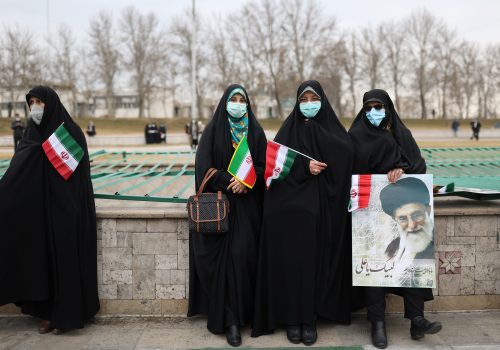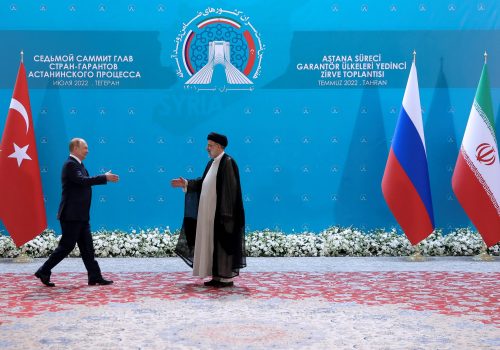Iran and the US face obstacles in their goals in the Middle East
The long rivalry between the United States and Iran reflects their differing views of an ideal regional order and contrasting methods of expanding influence. Both are facing obstacles and are unable to fully achieve their goals.
Since the 1979 revolution, Iran has sought to export its ideology of resistance and support for Islamic rule. A predominantly Shia country and linguistically different from many other countries in the region, Iran has tried to compensate for its strategic loneliness by establishing and expanding non-state actors in neighboring states. However, these actors have increased neighbors’ threat perceptions and undermined the formation of constructive ties with Iran.
The US has long been one of the Middle East’s most important players, seeking to protect its allies, such as Saudi Arabia and Israel, to secure energy exports and sell weapons. But it has also tried and failed repeatedly to pivot to Asia and reduce its military footprint in the Middle East.
Iran is a regional actor and the United States is a global power. Both countries seek a regional order in line with their interests. The hostile relations between the two reflect Iran’s desire to become the most important and influential power in the region and the US desire to prevent any one country from becoming dominant.
In the 1950s and 1960s, the primary US objective was to keep the Soviet Union from expanding its influence in the Persian Gulf. After the collapse of the Soviet Union and the US war against Iraq to liberate Kuwait in 1991, the US retained a significant military presence in the Middle East. The goal was to contain both Iran and Iraq and to establish new peace agreements between the Arab countries, the Palestinians, and Israel.
However, after the terrorist attacks of September 11, 2001, the United States turned its focus to combatting terrorism and proliferation. In 2003, the United States invaded Iraq on what turned out to be false evidence of a weapons of mass destruction program and, in so doing, triggered an insurgency that bogged the US military down in Iraq until the end of 2011. Then, just as Washington started to draw down its troops from Iraq, the Arab Spring began.
Some regional leaders allied with the United States were toppled and civil war broke out in Syria. The Barack Obama administration refrained from military intervention on a large scale but was forced to send troops back to Iraq and into Syria after the Islamic State of Iraq and al-Sham (ISIS) emerged and took Iraq’s second largest city, Mosul, in 2014. Hundreds of US troops remain in Iraq and Syria to check the resurgence of ISIS and provide training to Iraqi forces.
Despite repeated efforts to focus more on China, the US still has important interests in the Middle East. It seeks to ensure the free flow of oil, prevent the spread of nuclear weapons, fight terrorism, maintain the security of Israel, and promote democratic values where possible.
Iran, on the other hand, wants to expel the US from the region and, in some ways, replace it. According to a twenty-year vision plan released two decades ago, Iran should become the most important economic, military, and scientific power in the Middle East by 2025. Iran sees itself as the leader of the Muslim world bound to defend both Sunnis and Shias. At the same time, it champions the rights of Shia everywhere and seeks to end discrimination against them by Sunni governments.
To deter attacks against Shias, Iran has developed and projected hard power by expanding its conventional forces and its support for proxies in the region. Ideally, Iran would also like to spread its values in the region. Iran wants to weaken the US presence in the region and develop nuclear power to strengthen its bargaining position against Western-backed governments and institutions.
Iran perceives becoming the leading power in the Middle East as strengthening its security and deterring attacks on its homeland. But there are many constraints on this strategy that emanate from Iranian policies, which are perceived as aggressive by many of Iran’s neighbors as well as external powers. Many other countries in the region claim leadership in the Middle East. Egypt, Saudi Arabia, and Turkey also believe that they are entitled to an important if not dominant role. Even some of the small countries on the southern shores of the Persian Gulf see themselves as powerful actors. This has led to fierce competition in the region and support for conflicting non-state groups.
Ethnic and religious differences also challenge Iran’s aspirations. The sectarian split between Sunnis and Shias has deepened since the overthrow of Saddam Hussein in Iraq and there are also conflicts among Shias in Iraq that have proved difficult for Iran to control. This has been demonstrated by the opposition of Iraqi politician Muqtada al-Sadr to the formation of a government backed by rival Shia political and military factions.
It is clear that none of the regional players have sufficient capabilities to lead the Middle East alone. Iran’s model does not have enough appeal and acceptance.
Iran also suffers from the burden of multilateral and later unilateral sanctions that have persisted for many years. Iran faces many challenges in achieving its goals, and it may not be possible to become a leading country in the short term.
The United States has also been thwarted in its efforts to pivot toward Asia. At the same time, given the different levels of power between the US and Iran, it seems that the current situation in the region is more in line with US goals. Many Middle Eastern countries see Iran’s ambitions as a threat and have allied with the United States to contain the Islamic Republic. By pursuing a policy of what Tehran perceives as Iranophobia, the United States has also been able to achieve some convergence between some Arab countries and Israel.
No regional or extra-regional power can create an ideal regional order based on their interests in the Middle East. History suggests that a continuation of a balance of power is the most logical future outcome.
Ebrahim Meraji is director of the US – Middle East Studies Department,
Center for the Scientific Research & Middle East Strategic Studies (CMESS). Follow him on Twitter: @EbrahimMeraji.
Further reading
Wed, May 11, 2022
How Iran’s interpretation of the world order affects its foreign policy
IranSource By
There is a gap between the psychological milieu of Iranian political elites and the real-world balance of power.
Fri, Jul 22, 2022
Putin got what he wanted at the Tehran summit. But did Iran?
IranSource By Nadereh Chamlou, Mark N. Katz
Whatever the reason, Putin had cause to be pleased with his meetings with Iranian leaders in Tehran. But it is not clear that the Iranian leadership was equally as pleased.
Tue, Jun 14, 2022
Iran is now a transit transportation hub for neighboring countries. Here’s how it happened.
IranSource By Borzou Daragahi
Since the Iran trade route was opened in October 2021, roughly one thousand trucks have made the trip between Turkey and the UAE, mostly carrying goods from west to east.
Image: Deputy commander of the Iran's Revolutionary Guard Corps General Ali Fadavi (4th L) attends an anti-Israel protest in downtown Tehran on August 9, 2022. Iran's Revolutionary Guard Corps vice commander, General Ali Fadavi, said, As Iran's Supreme Leader stated and martyr General Qasem Soleimani has supported Palestinians, this support will continue and the Guard Corps will assist them. (Photo by Morteza Nikoubazl/NurPhoto)


